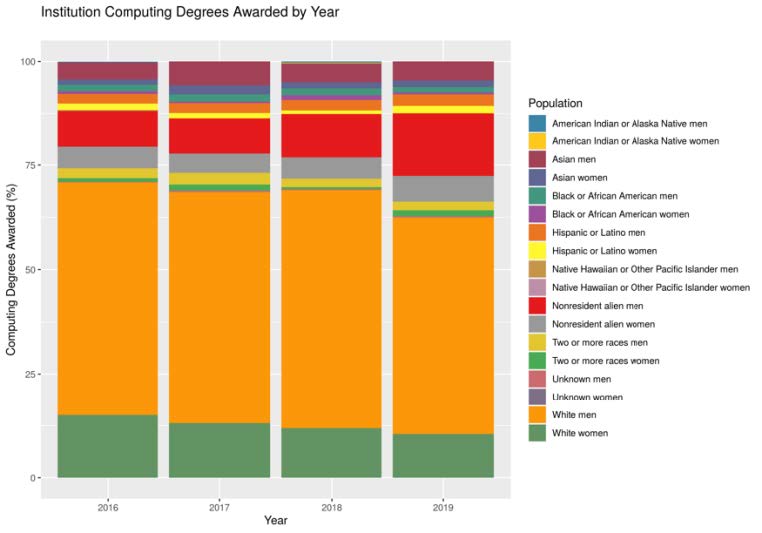Teams involved with technology that draw from a range of rich and diverse perspectives increase their performance capabilities when problem solving and innovating. The Luddy School of Informatics, Computing, and Engineering draws inspiration from everywhere for the next world-changing advances and life-saving solutions; our diverse perspectives provide a powerful edge for the next generation researchers, faculty, students and staff.
The vision of the Luddy School vision is of a community committed to diversity as a core strength and as a principle for maximum innovation, creativity, pedagogy, and scholarship. The Luddy School currently is falling short in its aspirations for recruitment and retention of students from underrepresented populations. For example, the distribution of undergraduate computing degrees awarded by Indiana University Bloomington across populations of students shows IUB trailing the state of Indiana and the nation in the percentage of degrees awarded to underrepresented populations. Also, although IUB performs slightly better than the state of Indiana in terms of degrees awarded to women, the total percentage (at 14.18%) falls far short of the proportion of the population that are women.
Additionally, undergraduate students from underrepresented populations are more likely than their peers to earn grades of D, F, or W (i.e., DFW) and earn overall lower grades in introductory courses1. These discrepancies persist into upper-level courses suggesting that we aren't simply “weeding out” underprepared students. Further, female students are less likely to sustain enrollment through upper-level courses.
In May 2020, Luddy School Interim Dean Dennis Groth and Associate Dean for Research Kay Connelly convened a Diversity, Equity, and Inclusion (DEI) Task Force with the objective of defining a strategic plan for the Luddy School and addressing the National Science Foundation’s Computer Information Science and Engineering Directorate (NSF CISE) requirement that grant proposals include Broadening Participation in Computing (BPC) plans in response to select NSF CISE solicitations. Under the leadership of Michael A. and Laurie Burns McRobbie Bicentennial Professor of Computer Engineering Beth Plale and Assistant Dean for Diversity, Equity, and Inclusion, Lamara Warren, a task force was formed. The task force's first meeting was held in August 2020, and its final report was delivered in August 2021.
Our vision for attaining inclusive excellence is:
The Luddy School reaches inclusive excellence through an ongoing process of self-reflection, analysis, engagement, and feedback. The Luddy School gives high priority to inclusive excellence in its strategic directions and resource allocations. The Luddy School reaches inclusive excellence when all members of the Luddy community strive for deep recognition and affirmation of who we all are, where we come from, and what kind of school we want to be.
The vision will be realized though six high-level objectives and associated metrics. The plan gives Luddy School departments and units the freedom to tailor implementations of the objectives to fit their needs. Metrics accompanying each objective provide the framing within which measurable progress can be made.
The high-level objectives of the plan for inclusive excellence are summarized as:
- Excellence in the Learning Experience and Pedagogy - increasing retention of graduate and UG students from underrepresented populations; and increasing levels of pedagogical excellence of those who teach. This objective deals with improvements to student retention rates and the in-classroom experience as orchestrated by course instructors.
- Welcoming to All: Luddy Community and Climate - strengthening the Luddy experience for students from underrepresented populations. This objective concentrates on the student experience outside the classroom, and on the faculty and staff experience as part of the Luddy School community.
- Inclusive Recruitment Practices - Student
- Inclusive Recruitment and Retention Practices - Faculty
- Inclusive Recruitment and Retention Practices - Staff
- Facilitating Broadening Participation in Computing (BPC) in Research - BPC Harness - The BPC Harness, a new program proposed here, assists faculty in identifying BPC efforts that are synergistic with the inclusive excellence vision and in connecting them with evaluation/assessment resources.
The Luddy School Strategic Plan for Inclusive Excellence documents an overarching set of objectives and metrics. Realization of the plan requires unit-level plans for its implementation. The unit-level implementation plans must align with and support the metrics that are defined in this plan. Progress towards a more diverse and inclusive school additionally requires broad adoption of the Plan for Inclusive Excellence. Our aim is that the vast majority of the faculty, staff, and student body of the IU Luddy School will regularly participate in activities that broaden participation in computing and create a more inclusive climate.
The Luddy School should convene a school-level, faculty-led, standing Committee for Inclusive Excellence that, in close coordination with the Luddy School Office of Diversity and Inclusion (LODI), is responsible for the success of the Luddy School Strategic Plan for Inclusive Excellence. Among other responsibilities, the standing committee should manage staff to support the BPC Harness, with the aim of lowering the activation energy for faculty to find and join BPC activities, and to administer assessment and reporting.
The Luddy School should retain expertise in evaluation and assessment to ensure optimal outcomes under this plan.
Additional resource requirements include better management, tracking, and analysis of data required to continually assess improvement under this plan, and administrative staffing to carry out climate surveys and assist with administrative duties.


